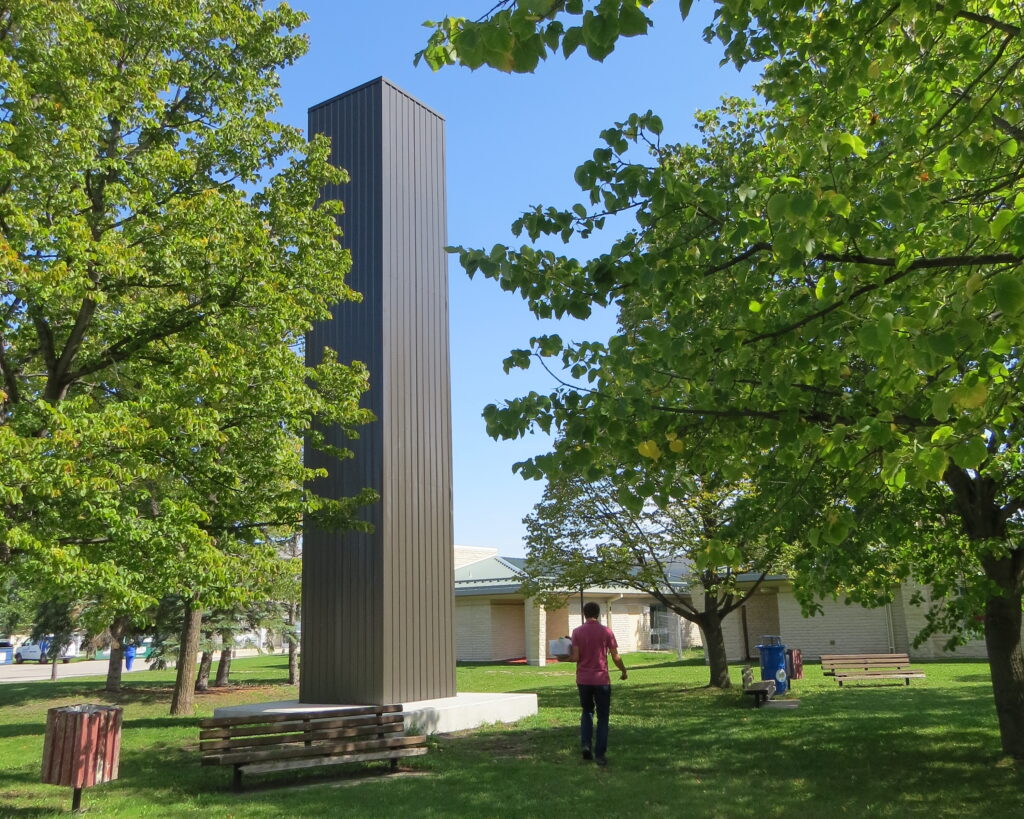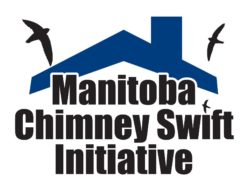Swift Science – Manitoba Research Rundown (Part 2)

Hello, fine folks!
Last week we posted part 1 of our Manitoba Research Rundown two-part series. Part 1 focused on Tim Poole, Barb Stewart, and Rob Stewart’s work on how different types of human disturbance impacts nesting Chimney Swifts in St. Adolphe. If you missed it, here’s the link to Part 1.
As promised, this week we are going to dive into another recent study focused on how other factors like weather impact nesting Chimney Swifts. We’re also going to touch on Manitoba’s journey with artificial towers, and what future research is in the works. Let’s get into it!
This study focused on how weather may impact nesting Chimney Swifts. Chimney Swifts are aerial insectivores, meaning that they eat insects while in flight, and rely on the presence of insects to be able to feed their young. Insect availability is affected by weather conditions; therefore, weather can be used as a proxy for prey availability for Chimney Swifts. Similar to the study discussed in last week’s blog post, Barb and Rob used monitoring data for the 5 sites in St. Adolphe. The data was divided in two periods: 2007-2013 and 2014-2022. They had access to local weather data from 2011-2022.
Barb and Rob also looked at differences in nest site performance. They ranked the different sites using the following factors: order of first occupancy in the spring, number of breeding attempts, number (%) of successful breeding attempts, number of fledglings produced based on visual or physical evidence, and number of consecutive years with successful breeding. They found that overall, the Church was ranked the highest in both periods while Brodeur Bros was ranked the lowest.

The Church chimney, the tallest of the nest chimneys in St. Adolphe. Photo by Rob Stewart.
Over the years, there were several nest failures. To see if weather conditions in the days leading up to the nest failure might have contributed to this outcome, they looked at the following parameters: hourly average air temperatures, hourly average wind speeds, maximum hourly wind speeds, and hourly rainfall. Based on other published studies, they considered air temperatures under 18.5°C and above 32°C to represent ‘reduced’ prey availability, and air temperatures under 15.5°C and above 34°C to represent ‘severely reduced’ prey availability. They found that of the 24 nest failures they evaluated, 21 were associated to daytime air temperatures under 18.5°C. In general, low temperatures often led to delayed nest building and reduced feeding rates while high temperatures were associated to reduced incubation exchanges and feeding rates.
Strong winds didn’t seem to be an important factor for nest failures. Wildfire smoke did seem to impact behaviour when it was a low-level in the atmosphere, associated to reduced to zero aerial insectivore activity depending on the density of the smoke. The impact of rain was difficult to assess because of low data. 2022 was a very wet year, with lots of rain and cold temperatures during the month of May. Nest building was delayed, but 4 out of 5 sites still had successful breeding attempts (a record). Barb and Rob speculate that nesting was delayed because of low insect numbers at the start of the season, but the surge in bugs later on in the season because of the wet spring conditions led to lots of food for the swifts towards the end of summer. I certainly remember that summer… the mosquitoes were atrocious! At least the swifts had lots to snack on.
Not all nest failures were linked to weather conditions; a few seemed to be caused by visits by ‘hostile’ non-parent adult swifts. By looking at which nesting attempts succeeded in years where many other nesting attempts failed, Barb and Rob also noticed that using a high-quality nesting site (such as the Church) or the presence of a helper seem to buffer the impacts of bad weather.
There were some differences between the two time periods. Overall, the breeding success rate was 39% from 2007-2013 compared to 44% from 2014-2022. In 2007-2013 compared to 2014-2022, the nest sites tended to be occupied earlier in the season, but the nesting stages all occurred later, and successful nesting sites remained occupied later into the season. At the end of the nesting season, there were often pre-migratory groups of roosting swifts. From 2014-2022, there were none of these pre-migratory groupings. In other words, the swifts have started to leave their nesting sites earlier and without forming pre-migratory groupings. Barb and Rob speculate that this earlier departure is because prey abundance is too low to support the swifts. Thus, they now head south as soon as their breeding cycle wraps up.
Overall, the study found that most nest failures lined up with cold and wet weather, which likely reduced the amount of prey available to the Chimney Swifts. As we looked at in-depth in the previous study, human disturbances such as rooftop repairs also contributed to some nest failures. Other factors that impacted nesting success were the quality of the site, the presence of helpers, interactions with other swifts, and human disturbances.
One interesting observation is that the site with the best performance rank (The Church) is the site with the tallest chimney (14.2m). The site with the worst performance rank (Brodeur Bros), is the site with the shortest chimney (7.0 m). This begs the question… does the height of a chimney or tower impact breeding success? Based on the St. Adolphe sites, it does appear that the taller the chimney, the better for the swifts. To further investigate this question, Barb and Rob have started a study that will look at Chimney Swift nest placement. They want to investigate factors like chimney height, nest height, which wall the nest is placed on, etc. Knowing which habitat characteristics are needed for successful breeding outcomes would help identify the best design and practices for habitat protection and creation.

A worker repairing the Brodeur Bros chimney (before the swift breeding season) in 2023, funded by MCSI. This chimney is the shortest nesting chimney in St. Adolphe. Photo by Rob Stewart.
As you probably know, MCSI is passionate about protecting existing habitat and creating new habitat for Chimney Swifts. We provide funding to repair chimneys used by swifts and conduct a lot of outreach to property owners about Chimney Swifts. Another important component of habitat stewardship for Chimney Swifts in Manitoba has been the use of artificial towers.
A bit of history on artificial towers in Manitoba…
The first artificial swift tower in Manitoba was built in 2008 – its design was based on plans by Paul & Georgean Kyle for towers they built in the southern U.S. Between 2008 and 2013, seven new towers were constructed in Manitoba. Unfortunately, no swifts have been observed using these towers. The probable explanation for this lack of use by swifts is in the design itself – though they worked in warmer climates, they likely were not able to keep the internal temperature stable enough for the swifts in Manitoba’s colder climate. Also, the towers were quite short which can make it easier for heavy rain to reach the inner chimney walls. If you’re curious to learn more, Tim has written a lot about these towers for the MCSI website.
With these issues in mind, a working group got together to design a tower that would be better suited to our northern climate. This new Manitoba-specific tower design, based on detailed schematics drawn by famous Manitoba architect Etienne Gaboury, was taller and was made of wood. This first tower of this kind was completed in 2015 and was initially set up at the site of the Old Grace Hospital.
Timing being everything, this tower was doomed as its original placement was in late July of 2015, well after the spring arrival of breeding swifts… This delay (and a few subsequent delays) likely contributed to the lack of use by swifts at the Old Grace Hospital location. Tim published a paper about the Old Grace Hospital tower and the importance of timing when it comes to building artificial towers – you can find study here or on the ‘Resources and Links’ page of our website.
The tower was moved to the Assiniboine Park Zoo in 2018. Though no swifts were seen entering or exiting the chimney in 2018, a successful breeding attempt was confirmed in 2019. Since then, the Assiniboine Park Zoo tower has supported a successful breeding attempt every year. In 2021, the outer wood siding was replaced with metal cladding after being damaged by a Pileated Woodpecker. In the words of Barb Stewart: “Teachable moment = don’t design your tower like a giant dead tree that sings out to a giant woodpecker looking for a cavity of its own!”

The Assiniboine Park Zoo tower before and after recladding.
In 2021, four artificial towers were constructed at the Selkirk Mental Health Centre, as mitigation for the destruction of three swift chimneys. These towers followed a similar design as the renovated Assiniboine Park Zoo tower and were built with rough sawn cedar on the inside, and steel cladding on the exterior. While the overall design is similar across the four towers, they are different heights, and one is attached to a building while three are freestanding. This variation is an opportunity to let the swifts show us what they prefer for tower characteristics. All four towers were used by swifts that same breeding season, and T4 was used for a successful breeding attempt! In 2022, T1 and T2 hosted successful breeding attempts, T4 hosted a failed breeding attempt, and T3 was used by swifts but not for nesting. In 2023, there was evidence that T1, T2 and T4 all likely hosted successful breeding attempts, while T3 was not used for nesting but was used by swifts.

One of the artificial towers in Selkirk (same overall design as the Assiniboine Park Zoo tower). Photo by Gerald Machnee.
Overall, the artificial towers have turned out to be a huge success in Manitoba. The success of these Selkirk towers confirms that the original Manitoba-specific design works and can be used successfully for habitat mitigation in Manitoba. Once again, this finding highlights the importance of our monitoring data! Because of MCSI’s eyes on the sky, we’ve generated intel that is being used by regulators that work to protect swift habitat, and that aim to create new artificial habitat!
Wrap-up
Welp, that was a lot of information! To sum up this two-part science series, there are a lot of factors that come together when it comes to the fate of breeding Chimney Swifts: climate change and weather patterns, human disturbance, habitat characteristics, adversarial swifts… These factors interact in all kinds of ways, some that we are beginning to understand and some that remain mysteries.
The key to everything we know so far, and to what we hope to discover, is the monitoring. Without monitoring, we don’t know much of anything! This is why MCSI’s monitoring program is such an important part of our program and to swift conservation as a whole. Knowing which sites are being used by swifts, if breeding outcomes are successful, etc., helps protect existing habitat and create new habitat. The more we learn, the more we can act in meaningful ways to conserve this species at risk. So once again, thank you every single one of you who given some of your time to watching the swifts. We couldn’t do it without you!
All this talk about swifts sure is getting me fired up for the upcoming monitoring season. Soon…
For now, I hope you are all enjoying the winter weather. Happy end of February!
-Marissa
